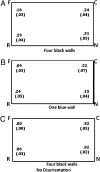Impaired geometric reorientation caused by genetic defect
- PMID: 20133673
- PMCID: PMC2840366
- DOI: 10.1073/pnas.0909155107
Impaired geometric reorientation caused by genetic defect
Abstract
The capacity to reorient in one's environment is a fundamental part of the spatial cognitive systems of both humans and nonhuman species. Abundant literature has shown that human adults and toddlers, rats, chicks, and fish accomplish reorientation through the construction and use of geometric representations of surrounding layouts, including the lengths of surfaces and their intersection. Does the development of this reorientation system rely on specific genes and their action in brain development? We tested reorientation in individuals who have Williams syndrome (WS), a genetic disorder that results in abnormalities of hippocampal and parietal areas of the brain known to be involved in reorientation. We found that in a rectangular chamber devoid of surface feature information, WS individuals do not use the geometry of the chamber to reorient, failing to find a hidden object. The failure among people with WS cannot be explained by more general deficits in visual-spatial working memory, as the same individuals performed at ceiling in a similar task in which they were not disoriented. We also found that performance among people with WS improves in a rectangular chamber with one blue wall, suggesting that some individuals with WS can use the blue wall feature to locate the hidden object. These results show that the geometric system used for reorientation in humans can be selectively damaged by specific genetic and neural abnormalities in humans.
Conflict of interest statement
The authors declare no conflict of interest.
Figures


Similar articles
-
Geometric and featural systems, separable and combined: Evidence from reorientation in people with Williams syndrome.Cognition. 2015 Nov;144:123-33. doi: 10.1016/j.cognition.2015.07.010. Epub 2015 Aug 10. Cognition. 2015. PMID: 26275835 Free PMC article.
-
Impaired behavioral and neural representation of scenes in Williams syndrome.Cortex. 2019 Dec;121:264-276. doi: 10.1016/j.cortex.2019.09.001. Epub 2019 Sep 20. Cortex. 2019. PMID: 31655392 Free PMC article.
-
In-depth analysis of spatial cognition in Williams syndrome: A critical assessment of the role of the LIMK1 gene.Neuropsychologia. 2006;44(5):679-85. doi: 10.1016/j.neuropsychologia.2005.08.007. Epub 2005 Oct 10. Neuropsychologia. 2006. PMID: 16216290
-
From genes to brain development to phenotypic behavior: "dorsal-stream vulnerability" in relation to spatial cognition, attention, and planning of actions in Williams syndrome (WS) and other developmental disorders.Prog Brain Res. 2011;189:261-83. doi: 10.1016/B978-0-444-53884-0.00029-4. Prog Brain Res. 2011. PMID: 21489394 Review.
-
Auditory and visual processing in Williams syndrome.Isr J Psychiatry Relat Sci. 2010;47(2):125-31. Isr J Psychiatry Relat Sci. 2010. PMID: 20733255 Review.
Cited by
-
A new biomarker to examine the role of hippocampal function in the development of spatial reorientation in children: a review.Front Psychol. 2015 Apr 24;6:490. doi: 10.3389/fpsyg.2015.00490. eCollection 2015. Front Psychol. 2015. PMID: 25964770 Free PMC article.
-
Impaired representation of geometric relationships in humans with damage to the hippocampal formation.PLoS One. 2011;6(5):e19507. doi: 10.1371/journal.pone.0019507. Epub 2011 May 18. PLoS One. 2011. PMID: 21611122 Free PMC article.
-
Geometric and featural systems, separable and combined: Evidence from reorientation in people with Williams syndrome.Cognition. 2015 Nov;144:123-33. doi: 10.1016/j.cognition.2015.07.010. Epub 2015 Aug 10. Cognition. 2015. PMID: 26275835 Free PMC article.
-
Route knowledge and configural knowledge in typical and atypical development: a comparison of sparse and rich environments.J Neurodev Disord. 2015 Dec 15;7:37. doi: 10.1186/s11689-015-9133-6. eCollection 2015. J Neurodev Disord. 2015. PMID: 26870305 Free PMC article.
-
Performance on the Kaufman Brief Intelligence Test-2 by Children With Williams Syndrome.Am J Intellect Dev Disabil. 2016 Jan;121(1):33-47. doi: 10.1352/1944-7558-121.1.33. Am J Intellect Dev Disabil. 2016. PMID: 26701073 Free PMC article.
References
-
- Cheng K. A purely geometric module in the rat’s spatial representation. Cognition. 1986;23:149–178. - PubMed
-
- Gallistel CR. The Organization of Learning. Cambridge, MA: MIT Press; 1990.
-
- Hermer L, Spelke E. Modularity and development: the case of spatial reorientation. Cognition. 1996;61:195–232. - PubMed
-
- Hermer L, Spelke ES. A geometric process for spatial reorientation in young children. Nature. 1994;370:57–59. - PubMed
-
- Learmonth AE, Newcombe NS, Huttenlocher J. Toddlers’ use of metric information and landmarks to reorient. J Exp Child Psychol. 2001;80:225–244. - PubMed
Publication types
MeSH terms
Grants and funding
LinkOut - more resources
Full Text Sources

